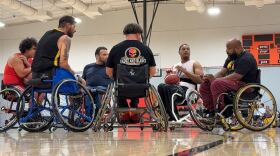Part one of a two-part series
KPBS Special Series
Baby Rebeka is just about the only one smiling on this morning at the emergency homeless shelter. That’s because it’s 5:30 a.m., and it was a long night.
Three dozen children and 43 women slept side-by-side on blanket-covered mattresses, laid out like a puzzle on the floor.
They stayed at the downtown San Diego Rescue Mission's Emergency Shelter For Women and Children because they had nowhere else to go.
Every morning, shelter residents hustle to get ready, pack their bags and go downstairs for breakfast. They eat up with one eye on the clock.

The older children have to get to school. But the babies and toddlers face a tough day with mom on the streets.
Children are one of the fastest growing segments of the U.S. homeless population. According to the National Coalition for the Homeless, 1.2 million children nationwide are homeless on any given night.
In San Diego County, 2,400 children stayed in emergency or transitional shelters in 2012. More than 40 percent of the children were under the age of 6.
The Rescue Mission sheltered 683 children in its emergency facility in 2012, up from 487 in 2010.
"The ability to supervise multiple children while you’re on the street is – for the best mom – difficult. For some of our moms, it’s impossible," said Shari Houser, vice president of programs at the San Diego Rescue Mission.
Houser said the shelter is only licensed to be open from 7 at night to 7 the following morning. For 12 hours during the day, moms with little ones are on their own.
Houser said most families end up in nearby parks or wandering the streets of downtown.
"Because they’re out, and they’re not connected with our facility when they leave, I’m not sure how much we don’t know," said Houser.
Houser said she does know one of the shelter’s 5-year-old boys was recently hit by a car as he was leaving the shelter, and that children are at risk of many other dangers.
"There are some of our moms who are in abusive relationships, and then when they leave here, they go try to get some place to stay for a day and the kids are seeing abuse," she said. "They’re seeing sexual abuse, they’re seeing drugs."

The Rescue Mission often extends its 30-day emergency shelter limit because waiting lists for longer-term shelters like St. Vincent de Paul Villages and YWCA Cortez Hill Family Center are currently two to four months long. In 2010, wait lists averaged three to four weeks.
After a long day, 24-year-old Robin Gorman checks back into the San Diego Rescue Mission’s emergency shelter with her two kids: 1-year-old Rebeka and 2 year-old Joshua.
Little Rebeka’s smile has faded.
"It’s hard with kids, stroller, bags," says Gorman.
Gorman and her kids have stayed at the shelter for seven weeks. She said she tries to make each day an adventure at the park.
"I usually lay out a blanket and put some toys on it. I go to the center so they’re not right by the street or by the sidewalk," said Gorman.
Other moms say they spend their days in line for welfare services with their kids strapped in their strollers much of the day.
Shari Houser said that's why there’s an urgent need for a preschool or daycare center at the Rescue Mission -- for moms like Gorman. She’s helping to put a proposal in motion.
"So this would be, I think a major step toward providing some kind of normal childhood for them," explained Houser. "And their childhood hasn’t been normal. They sleep in a shelter."

Houser envisions a beautiful classroom and modern playground equipment where children have a daily routine, nurturing teachers and healing.
"I want it to be the kind of preschool you would walk in as a mom or any mom would walk in and say ‘Wow, I would put my kid there,’" Houser said.
"And I want it to be something that they remember in the cycle of homelessness was okay," she added.
Gorman said a day care would allow her to go back to school.
I could know they’re safe," said Gorman, "they’re taken care of, and even if they miss me, they’re not alone. And I could go on with what I need to do so that we can get out of this situation."
Until then, she said she’s grateful when the shelter doors open and a warm meal is served.
After dinner, shelter residents return to the over-capacity bedroom walls to set up their mattresses and get ready for bed.
Everyone is hoping for some sleep, and that one night soon will be their last night of homelessness.







